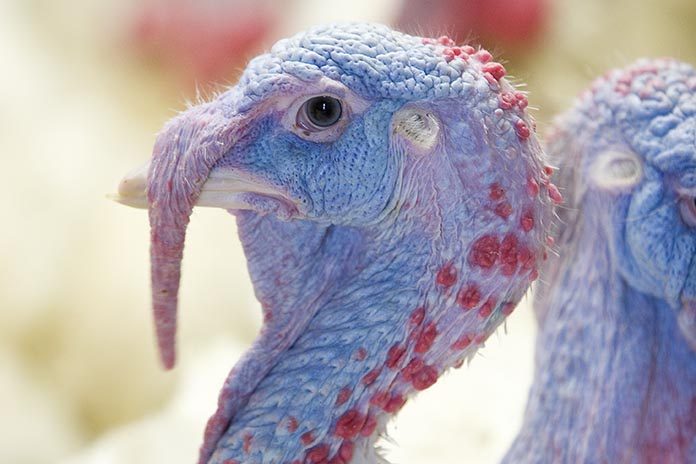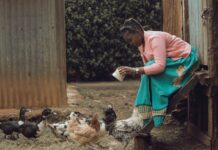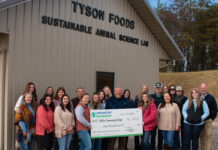
Avian influenza virus is stable longer in moist and cool conditions. Depending on seasonal and production conditions barn air and litter (bedding) moisture can create moist microenvironments where avian influenza virus can survive. Wet litter in turkey grower barns leads to leg problems and mortality in turkeys. Wet litter contributes to increased ammonia levels which combined with decreased ventilation and can lead to weight gain depression, damage to lung tissue, increased susceptibility to disease, and increased carcass condemnations during processing. Strategies for drying barns and litter include adding heat to the barn to evaporate litter moisture, tilling litter and/or adding more dry bedding. All of these practices are costly. Costs include energy costs for adding heat, tilling capital and operating costs, and bedding costs. Sharing tilling equipment between barns and hauling and distributing new bedding increase the risk of influenza introductions.
Another strategy for improving litter conditions that is expected to reduce avian influenza virus survivability is to use slotted flooring (SF). Research conducted 20 years ago at the University of Minnesota found that using SF to replace a portion of the bedded floor area resulted in drier litter where litter was used and reduced the amount of heat needed to remove moisture from the litter.
Slotted flooring had two negative impacts. Turkeys raised on partial SF developed more breast blisters, resulting in poor carcass quality and breast meat losses during processing. SF also led to drier and dustier conditions if the ventilating system was not managed properly to account for the reduced amount of moisture that needed to be removed by air exchange.In retrospect it seems that the type of slotted flooring and the amount of floor space allocated to slotted flooring needs to be adjusted. Newer SF materials are now available that may alleviate the e ffects on carcass quality. Research is needed to exam different slotted flooring materials to determine their suitability as a partial replacement for bedding without negatively impacting performance and carcass quality. Modern controllers and a better understanding of the minimum ventilating needs are expected to help barn managers to better manage dust levels.
Slotted flooring represents a major change in turkey flooring, manure handling and ventilation. A systems approach will be needed to assess SF materials, layouts, manure handling and ventilation options that will enhance turkey production and biosecurity practices.
Partially slotted flooring turkey grower barn concepts and advantages
Turkeys and broilers are typically floor-raised on litter. Slotted flooring is used extensively in the broiler/layer breeder portion of the poultry industry and in the swine industry. Experiences from the chicken breeder and swine industries may help anticipate how partially SF could be used in turkey production. The ideas presented are intended to begin discussions about how slotted flooring might be used in turkey grower barns.
Research conducted 20 years ago put slotted flooring under the feeders and waterers to collect faeces defecated around feeders and waterers and to collect spilled water. This concept was based on the observations that the wettest litter was around feeders and waters and that removing a major portion of the manure and spilled water would keep the remaining litter drier. The slotted flooring covered 21% to 34% of the floor area in the two studies. The litter moisture content in pens with partially SF was consistently lower than the pens with litter only. The partially SF moisture ranged from 10 to 60% lower than the litter from litter only pens.
In cold weather ventilating systems for animals housed in mechanically and naturally ventilated barns are sized based on the amount of air exchanged needed to remove moisture and manage both litter moisture and barn humidity. By collecting and removing the faeces and spilled water in liquid form with the slotted flooring reduces the need to evaporate the water and remove the moisture through the ventilating air. With partially slotted flooring the minimum ventilating rate can be reduced because less moisture needs to be removed by ventilation. In one study the ventilating rate in the partially slotted floor rooms were 78 to 86% lower than the ventilating rates in the litter only rooms.
Most new caged-layer barns collect and remove manure multiple times a week using belts. By removing manure from the barn before microbial activity can convert urea into ammonia reduces ammonia emissions from the manure in the barn. Ammonia levels measured in the partially slotted floor rooms with turkeys were consistently less than the levels in the litter only rooms even at the lower ventilating rates.
Partially slotted flooring saves energy because the minimum ventilating rate can be reduced and bird and supplemental heat energy is not needed to evaporate moisture in the litter from faeces and spilled water to maintain litter moisture conditions. In one study with turkeys raised on partially slotted floors the energy use was decreased by 42% and 62%.
Results from the partially slotted flooring studies indicated lower incidences of leg problems and faster growth rates. Drier litter, separating the birds from more of their faeces and lower ammonia levels are believed to be contributing factors to these performance indicators. Separating turkeys from more of their faeces is expected to reduce disease challenges too.
Partially slotted flooring turkey grower barn challenges
There are known challenges that need to be overcome and questions that need to be answered before partially SF will be widely adopted. One challenge is that turkeys raised on partially slotted flooring develop more breast blisters and buttons that result in downgrading during processing. Similar problems were found with broilers raised on wire flooring.
Research conducted to date has not determined what causes the breast blisters but it is thought that the turkeys may roost on the edge of the slotted flooring or the flooring itself and that this behaviour leads to breast buttons and blisters. Research is needed to test flooring materials and different installations to determine what causes the breast blisters and which flooring systems might reduce breast blister incidence.
Research is also needed to assess alternative SF designs and materials to find those that allow faeces to pass easily, remain relatively clean, do not plug with feathers, provide good footing for both birds and workers, and provides structural support of people and equipment that must cross the SF.
Partially slotted flooring also represents a significant investment in new manure handling equipment and a need for equipment to handle both litter and the manure slurry from under the slats. Layer barns use manure belts under the cages to collect and remove manure multiple times a week. Manure scrapers are another option for removing manure from a barn.
Partially slotted flooring will require removing manure multiple times per week and new manure handling equipment and storage facilities. Turkey manure without bedding is reportedly 75% water. Manures with solids contents between 10 and 16% can be handled as a semi-solid which means it can be moved with a piston pump, auger or other equipment used to move solid manure. With manure removed multiple times a week the manure must be stored until it can be land applied at appropriate rates based on the farms nutrient management plan. The new manure handling equipment and manure storage facilities will represent an additional capital and operating investment.
The new manure handling and storage system will result in different nutrient levels in the manure for land application and nutrient management planning. Nutrient management plans for turkey operations are based on the nutrients levels in litter based manure. With partially SF systems the manure characteristics and nutrient levels may be different.
New ventilation systems and guidelines will need to be developed because rates will be able to be lowered because less moisture needs to be removed by air exchange during cold weather. Excess air exchange will waste heat and lead to dusty conditions.
Current slotted flooring research (preliminary observations)
More research and analysis is needed to develop recommendations for partially slotted flooring systems for raising turkeys that get the best return from enhanced air quality and lower energy costs while reducing the potential for breast blisters and disease and the additional capital costs and operational changes needed.
To build on past research in this area, a pilot study was recently conducted at the UMore Park Turkey Research Unit (Rosemount, MN) to compare five different flooring materials with a conventional bedded system. The five flooring materials were:
- Double L Classic Red Rooster 75×2.5” rectangular 45% 18×32”;
- SW Ag Plastics Dura-Slat 1.1×1.1” square 24×48”STO;
- SW Ag Plastics Dura-Slat 1.1”1” square 24×48”ST;
- Tenderfoot 0.875×2.18” rectangular;
- and Tenderfoot 1” square
Each treatment was allocated to two replicate pens with 50 toms per pen. Turkeys (male, Hybrid Converter) were moved to the study facility containing flooring at 5 weeks of age and performance followed to 18 weeks of age. Flooring occupied 25% of the pen floor. A small pit under the flooring area collected waste which was removed weekly. The remaining area of the pen floor contained fresh wood shavings as did the conventionally bedded pens.
Performance, litter condition, behaviour and health related measurements were monitored throughout the study. Not all data has been completely summarized. No differences among treatments were detected for 18 wk body weight, feed efficiency (5 to 18 wks of age), liveability, or breast blister/button scores at 18wks of age. Scores for breast blisters and buttons were quite variable though from pen to pen. For the flooring treatments, the proportion of turkeys with the more severe breast scores ranged from 2.3 to 8.6% while the turkeys reared on conventional litter floor averaged 6.6 % severe blisters. Processing plant data indicated similar performance among treatments for breast trim.
Conclusion
Collection and periodic removal of excreta from the barn (separating the bird from its excreta) has numerous benefits including reduced litter moisture, reduced energy usage as a result of less moisture to remove, and reduced contact with excreta that may be contaminated with pathogens. Less bedding usage and litter care may result. With market-type poultry – turkeys and broiler chickens, leg issues and carcass deformities can occur if floor surface is not appropriate. The preliminary results of this pilot study indicate that a partially slotted flooring system maybe a suitable alternative to conventional bedded system.
References are available on request
Prepared for the 2017 Midwest Poultry Federation Convention

















